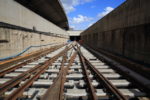The long-awaited report into the failures of the floating bridge has finally been released to the public – at 16:12 … on a Friday … in the downtime between Christmas and New Year … while everyone is distracted with friends and family. The process started in September 2017.
Carried out by two Isle of Wight councillors and two members of council staff, “to explore questions regarding the £3.7 million project, including aspects of project management and governance, staff training and public engagement as well as well-publicised concerns over chain depths and noise”.
Stewart: It’s “not about apportioning blame”
In the accompanying press release, Dave Stewart, currently leader of the council points out that the report is, “not about apportioning blame”.
He says,
“A number of technical design issues have been the subject of legal conversations between the council and contractors. These were not considered as part of this review process and are not detailed in the report for legal reasons.”
Stakeholders react
The Stakeholders have given their initial reaction (in full below) and it’s not very complementary, saying “we have very serious concerns about this report as highly inaccurate.”
28 pages long
The report is 28 pages long, so will take sometime to read over and digest. OnTheWight presents both the report and the PwC summary of their findings.
The council’s press release in full is also below.
Council report
PwC summary
IWC press release
A much-awaited review report into the design, build and delivery of the new Cowes floating bridge has now been published in preparation for the council’s Scrutiny Committee meeting to be held on 9 January 2018.
The report – commissioned and presented by council leader, Councillor Dave Stewart – sought to explore questions regarding the £3.7 million project, including aspects of project management and governance, staff training and public engagement as well as well-publicised concerns over chain depths and noise.
It examines all the activity from the initiation of the project proposal in 2013, through to the present time. It recognises that no issues were identified with the new vessel until it went into service in May 2017.
Since the vessel was first brought into service in May 2017, in addition to the £3.7 million that it cost to build it, addressing the subsequent issues related to it have cost the council a further £832,000 to maintain the link across the river between East and West Cowes whilst the vessel was out of service, as well as causing a great deal of disruption to the lives of the local communities.
“For me, this review has been about examining what happened and learning lessons for the future. I wanted to know exactly why and how the problems that have been experienced with the floating bridge arose in the first place and if they could have been handled differently by the council on behalf of Island residents. Ultimately, I was asking the question ‘why did we end up where we are?’,” said council leader, Councillor Dave Stewart.
“This report is not about apportioning blame – it is about ensuring that when we have high value, high profile or complex technical projects in the future, we get them right. We absolutely owe this to all our council taxpayers and residents.”
A number of technical design issues have been the subject of legal conversations between the council and contractors. These were not considered as part of this review process and are not detailed in the report for legal reasons.
The report also recognises that insufficient familiarisation and training time was allowed between the floating bridge arriving in Cowes and going into service and this may also have been a further contributing factor to the subsequent issues experienced.
The report makes a number of recommendations aimed at improving delivery of future capital projects as well as addressing findings regarding the current vessel.
Councillor Dave Stewart concluded:
“It is important to stress that following significant effort by many people Floating Bridge Number 6 has been running during December as part of an extended trial period. And we hope that as soon as all issues have been finally resolved we can once again return to a permanent service on this vital Cowes to East Cowes crossing.”
“It’s clear that the Council has not listened to the stakeholders, and in no way does it meet the Statement of Requirements or the minimum of what a good floating bridge needs to do.
“This floating bridge is unreliable and infrequent amongst many other problems, and we have very serious concerns about this report as highly inaccurate, and we look forward to proper scrutiny from Scrutiny Committee and that they clearly recommend not accepting this floating bridge.
“We are pleased that the Council finally recognised that this floating bridge weighs much more than floating bridge 5 (still slightly inaccurate), but apparently they have not looked properly into the problems that the weight can cause with the tide.
“We still recommend that the Council secure a low-interest loan to either commission a new floating bridge or radically alter this one until it is frequent, reliable, and safe and only requires two staff, and to use the profits from the vehicle fares to pay back the loan. This will not be a burden to the Council or impact its budget.”
Update 18:28 Added Stakeholders reaction
Image: © Karl Love





